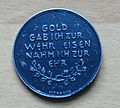I gave gold for iron
I gave gold for iron was a slogan which in time of war calling for, gold and jewelry to finance the war to donate. In return, the donor received iron jewelry .
Wars of Liberation
The Kingdom of Prussia declared war on the French Empire, led by Napoleon Bonaparte , on March 17, 1813. In the Sixth Coalition War , Prussia and its allies wanted to use Napoleon's defeat in the Russian campaign in 1812 to end the French era and to achieve the liberation of Germany from French occupation.
In 1813, Princess Marianne von Prussia appealed to all women in Prussia to exchange their gold jewelry for a brooch or a ring made of iron with the inscription GOLD I GAVE FOR EISEN . In doing so, she supported Rudolph Werkmeister's appeal published on March 31, 1813 in Berlin. This request was complied with many times. Iron jewelry became the fashion of all patriot women who showed their contribution to the support of the wars of liberation .
First World War
The appeal was repeated during World War I. Wedding rings, brooches and jewelry rings were given out to citizens willing to donate. Some of these were decorated with the Iron Cross .
Despite (or because of) her voluntariness, the action generated considerable social pressure. The social control was simple: Those who wore the iron jewelry had proven themselves to be patriots, those who continued to show gold lost their reputation.
The appeal also concerned the assets of associations, parishes and government agencies. The Kulturhistorisches Museum Magdeburg shows the mayor's iron chain of office made in 1917 .
From 1916, the Reichsbank rewarded the surrender of jewelry or the exchange of gold for paper money (which quickly lost value) with a medal . Precious metals such as gold and silver were essential raw materials for war and foreign exchange. The medals designed by Hermann Hosaeus were issued in many variants and in very high editions. They are made of blackened iron, weigh 16.4 to 20.4 g and have a diameter of 39 to 41 mm.
Emmerich Kálmán composed an operetta under this title in 1914 (libretto: Károly Bakonyi). It is set in the fall of 1914 during the war. Margarethe Pauly also dealt with the subject and published the novel I gave gold for iron in 1933 under the pseudonym "Anja Berg" .
literature
- Ernst Müsebeck: I gave gold for iron. Germany's disgrace and elevation in contemporary documents, letters, diaries from 1806–1815. Braunschweig 1998 (reprint of the Berlin 1913 edition).
Web links
Individual evidence
- ^ Adolf Streckfuß : 500 years of Berlin history. From fishing village to cosmopolitan city. Volume 2. Berlin: A. Goldschmidt 1886, p. 681. The call of March 31, 1813 appeared on April 3, 1813 in the Spener'sche Zeitung .
- ^ City of Magdeburg .
- ↑ for gold donation from German-Americans




